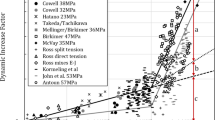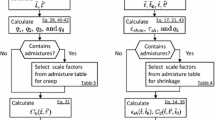Abstract
The double power law, which was previously shown to be capable of representing test data quite closely, is here developed as a model for practical prediction of creep at constant humidity and temperature from the composition of concrete mix, strength, age at loading and load duration. Extensive supporting comparisons with test data from the literature are given.
Résumé
La loi de double puissance que l'on a précédemment montrée comme étant apte à traduire avec une très bonne approximation les résulats d'essai est développée ici en tant que modèle de prévision pratique du fluage à humidité et température constantes à partir de la composition du mélange, de la résistance, de l'âge au chargement et de la durée de celui-ci On donne à l'appui des comparaisons que l'on développe avec les résultats d'essai publiés.
Similar content being viewed by others

References
Rostàsy F. S., Teichen K.-Th., Engelke H.—Beitrag zur Klärung der Zusammenhanges von Kriechen und Relaxation bei Normal-beton. Amtliche Forschungs-und Materialprüfungsanstalt für das Bauwesen. Otto-Graf-Institut, Universität Stuttgart, Strassenbau und Strassenverkchstechnik, Heft 139, 1972.
Hanson J. A.—A ten-year study of creep properties of concrete. Concrete Laboratory, Report No. Sp-38, U.S. Department of the Interior, Bureau of Reclamation, Denver, Colorado, July 1953.
Harboe E. M. et al.—A comparison of the instantaneous and the sustained modulus of elasticity of concrete. Concrete Laboratory Report No. C-854, Div. of Engng. Laboratories, U.S. Dept. of the Interior, Bureau of Reclamation, Denver, Colorado, March 1958.
C.E.B. (Comité Européen du Béton), 3rd Draft of Model Code for Concrete Structures,Bulletin d'Information No. 117-F, Paris, Dec. 1976.See also C.E.B.-F.I.P. Model Code, Congress of F.I.P. in London, May 1978.
Bažant Z. P., Osman E.—Reply to Rüsch, Jungwirth, and Hilsdorf's Second Discussion of the Paper “On the Choice of Creep Function for Standard Recommendations on Practical Analysis of Structures”, Cement and Concrete Research, Vol. 7, 1977, p. 119–130.
Bažant Z. P., Panula L.—A note on amelioration of the creep function for improved Dischinger method. Cement and Concrete Research, Vol. 8, 1978, No. 3.
Bažant Z. P.—Viscoelasticity of porous solidifying material—Concrete. Proc. Am. Soc. of Civil Engrs, J. of the Engng. Mech. Division, Vol. 103, 1977, p. 1049–1067.
Maity K., Meyers B. L.—The effect of loading history on the creep and creep recovery of sealed and unsealed plain concrete specimens. Report No. 70-7 prepared under National Science Foundation Grant GK-3066, Dept. of Civil Engng., University of Iowa, Iowa City September 1970.
Pirtz D.—Creep characteristics of mass concrete for Dworshak Dam, Report No. 65-2, Structural Engineering Laboratory, University of California, Berkeley, October 1968.
Ross A. D.—Creep of concrete under variable stress. American Concrete Institute Journal, Vol. 54, 1958, p. 739–758.
Browne R. D., Blundell R.—The influence of loading age and temperature on the long term creep behaviour of concrete in a sealed, moisture stable state. Materials and Structures (RILEM, Paris), Vol. 2, 1969, p. 133–143.
Browne R. D., Burrow R. E. D.—Utilization of the complex multiphase material behavior in engineering design, in “Structure, Solid Mechanics and Engineering Design”, Civil Engng. Materials Conf. held in Southampton 1969, Ed. by M. Te'eni, Wiley Interscience, 1971, p. 1343–1378.
Browne R. D., Bamforth P. P.—The long term creep of the Wylfa P. V. concrete for loading ages up to 12 1/2Years, 3rd Int. Conf. on Struct. Mech. in Reactor Technology, Paper H 1/8, London, September 1975.
Wittmann F. H.—Vergleich einiger Kriechfunktionen mit Versuchsergebnissen, Cement and Concrete Research, Vol. 1, No. 7, 1971, p. 679–690.
Brooks J. J., Neville A. M.—Estimating long-term creep and shrinkage from short-term tests. Magazine of Concrete Research, Vol. 27, No. 90, March 1975, p. 3–12.
Jordaan I. J., Illston J. M.—Time-dependent strains in sealed concrete under systems of variable multiaxial stress. Magazine of Concrete Research, Vol. 23, No. 75-76, June–September 1971, p. 79–88.
Bažant Z. P.—Phenomenological theories for creep of concrete based on rheological models, Acta Technica CSAV (Prague), Vol. 11, 1966, p. 82–109.
Nielsen L. F.—Reply to Bažant's and Jordaan's Discussions of the Paper “On the Applicability of modified Dischinger Equations”, Cement and Concrete Research, Vol. 8, 1978, p. 123–128.
Rüsch H., Jungwirth D., Hilsdorf H. K.—Second Discussion of the Paper “On the Choice of Creep Function for Standard Recommendations on Practical Analysis of Structures”, Cement and Concrete Research, Vol. 7, 1977, p. 111–118.
Bažant Z. P., Kim F. S.—Can the creep curves for different ages at loading at loading diverge? Cement and Concrete Research, Vol. 8, No. 5, September 1978.
Author information
Authors and Affiliations
Rights and permissions
About this article
Cite this article
Bažant, Z.P., Panula, L. Practical prediction of time-dependent deformations of concrete. Matériaux et Constructions 11, 317–328 (1978). https://doi.org/10.1007/BF02473873
Issue Date:
DOI: https://doi.org/10.1007/BF02473873



